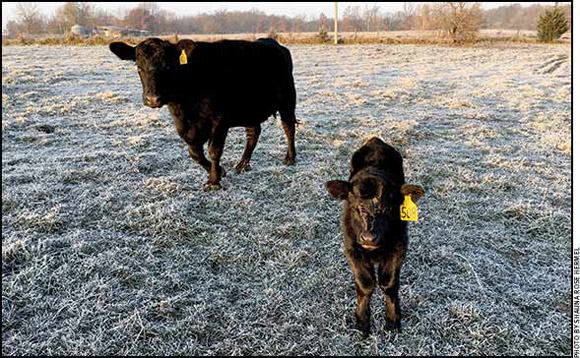MANAGEMENT...

On Target
Docility: Performance or convenience trait?
As calving season approaches, many ranchers look forward to the newborns that represent hours of studying sire summaries and bull sale books. For all the optimism, however, there’s one source of lingering dread: the cow or cows that you know should have been culled due to attitude. You hoped she’d be open at pregnancy check, after that one last tour across the pasture she led when you thought the herd was corralled — and you know that tagging tool makes a poor defense mechanism when you try to work her calf. You tell yourself she is fine after she calves, and “mothering ability” is important. Read more.
Putting Preg-check Results to Work
Evaluate management decisions by analyzing pregnancy rates.
The day you pregnancy-check is one of the most important days on the ranch as it is the day when we find out which cows are pregnant and how many calves we can expect come calving season. So now that the veterinarian has left the yard and the open cows are sorted off, what’s next? Before throwing the preg-check list on the dashboard, never to be looked at again, try to reflect on the results. Take some time to sort through them to uncover valuable information to assist with breeding-season management and what to expect for the upcoming calving season. Read more.
Tips for Calving Facilities
Follow these pointers to choose the best calving facilities for your ranch.
In some climates calving barns are a necessity if calving occurs early — as some western ranchers do if they want cows calved and bred before going to summer range. Many seedstock breeders calve early in order to have bull calves old enough to sell as yearlings in their next sales. In some climates you may only need a shed with room for two or three cows — just the ones that might be brought in for assistance. In other climates, you may need room for as many cows as might be calving during any 24-hour period. Read more.
Options for Managing Winter Manure Nutrients on Beef Farms
Depending on weather, available equipment and labor, beef farmers can choose the system that fits best.
An overwintering, cow-calf beef herd produces manure — quite a lot of it. In one day, the average 1,250-pound (lb.) beef cow produces 75 lb. of manure and urine. This manure has approximately 0.31 lb. of nitrogen (not all of this is retained), 0.19 lb. of phosphate and 0.26 lb. of potassium. The feeding method beef farmers use to deal with this nutrient resource can have a positive impact on their forage and other crop production system.
Care should be taken to not overfeed in an area. Too great of an accumulation of wasted hay and manure can have a negative impact on forage yield next year. Read more.

Kris Ringwall
Beef Talk
New Year’s resolution: Earn $300 more per cow.
Every new year brings with it a New Year’s resolution, and this year, mine would be to earn an extra $300 per cow.
Think about it. Why not make it happen? I would anticipate trying would be better than simply griping.
A new year started, and analysis of the last year needs to get serious by producers asking the tough questions. Perhaps then, the resolution can gain in strength.
The joy of sharing trends with producers is rewarding, but the documentation of the change that may have resulted from sharing educational information sometimes remains a frustration. Did change happen? Were producers better off? Read more.
New Products
Industry affiliates provide a wide array of products and services to assist you on the farm and ranch. Here’s an assortment of new products to hit the market recently.
- More cells per straw
- Detection kit for Johne’s disease
- Single-nostril respiratory protection
- Oxygen barrier film
- Center-pivot mower
Setting Posts in Frozen Ground
Strategies offered to help you tackle the job.
Occasionally a person needs to build or rebuild a permanent fence in the winter, and the biggest challenge is setting posts in frozen ground. If the frost is too deep to pound posts, one solution is to use a metal “post” to create a pilot hole. The pilot post will often go down through rocky ground, pushing aside the rocks, and will also penetrate frozen ground, whereas a wood post would be forced out of line or would shatter. Michael Thomas, a rancher and custom fence-builder at Baker, Idaho, uses a 7-foot-tall metal pilot post to create holes for wood posts in difficult conditions. Read more.
Angus Advisor
Click here for February herd management tips from cattle experts across the nation. Advice separated by region.
[Click here to go to the top of the page.]






